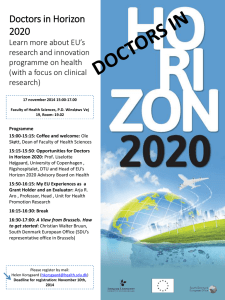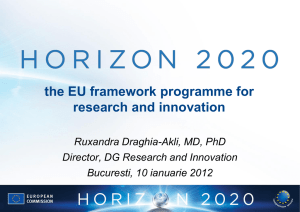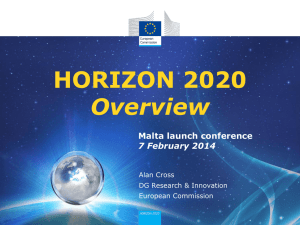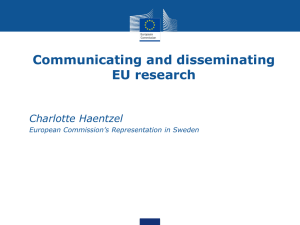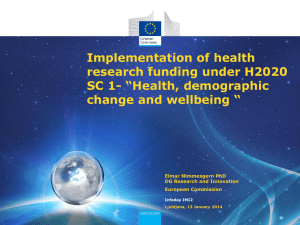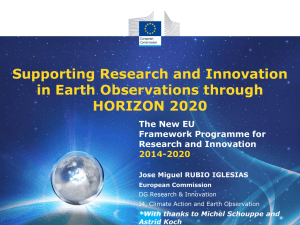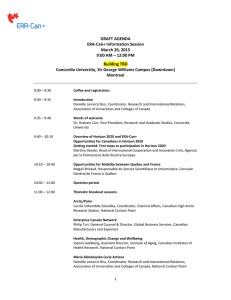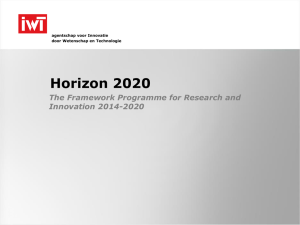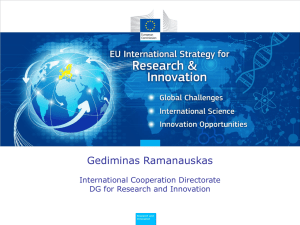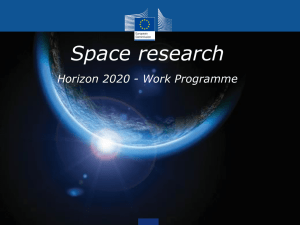Horizon 2020 - Research Management Centre (RMC)
advertisement
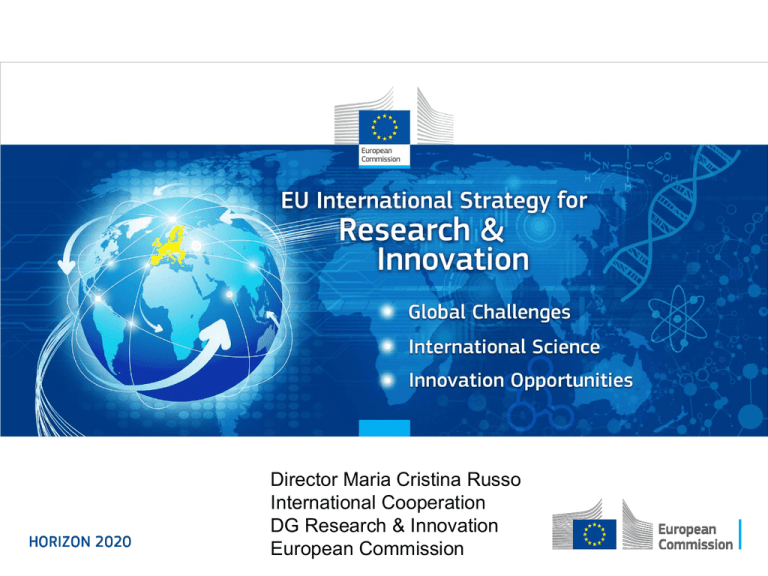
Enhancing and focusing EU international cooperation in research and innovation: A strategic approach Director Maria Cristina Russo International Cooperation DG Research & Innovation European Commission HORIZON 2020 EU Framework Programme for Research and Innovation 2014-2020 For info www.ec.europa/research/horizon2020 Pierrick.Fillon@ec.europa.eu International cooperation International cooperation = key cross-cutting priority of Horizon 2020, in particular to: Strengthen the Union's excellence/competitiveness (growth and jobs) Tackle global societal challenges Support the Union's external policies Clear benefits of encouraging international participation for MS/AC (through NCPs): access to knowledge, open up markets, attract talent, science diplomacy etc. Basic approach provided by Horizon 2020 Regulation and Rules for Participation Strategy for international cooperation (COM(2012) 497): enhancing and focusing international cooperation activities (in terms of areas and partners) International cooperation in Horizon 2020 Key messages: Horizon 2020 is open to participation from across the world! Clear ambition to substantially increase participation of international partners! How: General opening Targeted international cooperation actions across Horizon 2020 Supported by horizontal international cooperation activities (in Horizon 2020 Challenge 6: follow-up to Capacities INCO programme) General opening Horizon 2020 is open to participation from across the world Participants from other countries funded all ASEAN, but for Singapore: assessment) when the Commission deems it essential (case by case Promotion of general opening Important to get key messages and information on Horizon 2020 across to third countries: World's largest funding programme for research and innovation Strong investment in growth and jobs Tackling societal challenges Open to all and providing access to European excellence and innovation Simplified access Important communication campaign planned towards third countries to stimulate participation Targeted actions Targeted international cooperation activities across Horizon 2020: area for cooperation and partner specified upfront Areas identified based on analysis of a set of criteria to ensure common interest and mutual benefit: • • • • Research and innovation excellence Framework conditions/access to markets Contribution to international commitments Frameworks to engage in cooperation and lessons learned Differentiation by countries/regions: enlargement/neighbourhood/EFTA, industrialised and emerging countries, developing countries International cooperation as part of strategic planning for each part of Horizon 2020 Result: roadmaps for international cooperation with international partners (to be published early 2014) Implementation in Horizon 2020 Regular calls for proposals: topics inviting projects where third country participation is required and/or encouraged topics stimulating networking between existing projects Joint initiatives of Union and third countries: bilateral coordinated/joint calls multi-lateral initiatives contribution of Union to third country/international organisations ERA-Net The Multiannual Financial Framework 2014-2020: European Council conclusions, 8 February 2013 Key challenge: stabilise the financial and economic system while taking measures to create economic opportunities 1. Smart & inclusive growth (€451 billion) Education, Youth, Sport Connecting Europe Cohesion Competitive Business SMEs HORIZON 2020 2. Sustainable growth, natural resources (€373 billion) 3. Security and citizenship (€16 billion) 4. Global Europe (€58 billion) 5. Administration (€61.6 billion) TOTAL €960 billion Investment in R&D is part of the solution to exit from the economic crises What is Horizon 2020 • Initial Commission proposal for a €80 billion research and innovation funding programme (2014-2020); now just over €70 billion (79 billion in current prices including inflation) • A core part of Europe 2020, Innovation Union & European Research Area: − Responding to the economic crisis to invest in future jobs and growth − Addressing people’s concerns about their livelihoods, safety and environment − Strengthening the EU’s global position in research, innovation and technology What's new • A single programme bringing together three separate programmes/initiatives* • Coupling research to innovation – from research to retail, all forms of innovation • Focus on societal challenges facing EU society, e.g. health, clean energy and transport • Simplified access, for all companies, universities, institutes in all EU countries and beyond ⃰ The 7th Research Framework Programme (FP7), innovation aspects of Competitiveness and Innovation Framework Programme (CIP), EU contribution to the European Institute of Innovation and Technology (EIT) Three priorities Excellent science Industrial leadership Societal challenges Priority 1. Excellent science Why: • World class science is the foundation of tomorrow’s technologies, jobs and wellbeing • Europe needs to develop, attract and retain research talent • Researchers need access to the best infrastructures Proposed funding (€ million, 2014-2020)* European Research Council (ERC) Frontier research by the best individual teams Future and Emerging Technologies Collaborative research to open new fields of innovation 13 095 2 696 Marie Skłodowska-Curie actions (MSCA) Opportunities for training and career development 6 162 Research infrastructures (including e-infrastructure) Ensuring access to world-class facilities 2 488 ⃰ All funding figures in this presentation are subject to the pending Multiannual Financial Framework Regulation by the EP and the Council Priority 2. Industrial leadership Why: • Strategic investments in key technologies (e.g. advanced manufacturing, micro-electronics) underpin innovation across existing and emerging sectors • Europe needs to attract more private investment in research and innovation • Europe needs more innovative small and medium-sized enterprises (SMEs) to create growth and jobs Proposed funding (€ million, 2014-2020) Leadership in enabling and industrial technologies (LEITs) (ICT, nanotechnologies, materials, biotechnology, manufacturing, space) 13 557 Access to risk finance Leveraging private finance and venture capital for research and innovation Innovation in SMEs Fostering all forms of innovation in all types of SMEs 2 842 616 + complemented by expected 20% of budget of societal challenges + LEITs and 'Access to risk finance' with strong SME focus Priority 3. Societal challenges Why: • Concerns of citizens and society/EU policy objectives (climate, environment, energy, transport, etc) cannot be achieved without innovation • Breakthrough solutions come from multi-disciplinary collaborations, including social sciences & humanities • Promising solutions need to be tested, demonstrated and scaled up Proposed funding (€ million, 2014-2020) Health, demographic change and wellbeing 7 472 Food security, sustainable agriculture and forestry, marine and maritime and inland water research and the Bioeconomy 3 851 Secure, clean and efficient energy * 5 931 Smart, green and integrated transport 6 339 Climate action, environment, resource efficiency and raw materials 3 081 Inclusive, innovative and reflective societies 1 310 Secure societies 1 695 Science with and for society 462 Spreading excellence and widening participation 816 ⃰ Additional funding for nuclear safety and security from the Euratom Treaty activities (2014-2018) Horizon 2020 and partnering Public private partnerships: • Through Joint Technology Initiatives or other formal structures (Art. 187) • Through contractual agreements, which provide inputs for work programmes • Only when criteria met, e.g. clear commitments from private partners Public public partnerships: • Through « ERA-Nets » for topping up individual calls/actions (replacing current ERA-Net, ERA-Net Plus, Inco-Net, Inno-net) • Through participation in joint programmes between Member States (Art. 185) • Supporting agendas of Joint Programming Initiatives when in line with Horizon 2020 • Only when criteria met, e.g. financial commitments of participating countries European Innovation Partnerships: • Not funding instruments, but for coordination with broader policies and programmes Innovation Investment Package €22 billion Innovation Investment Package Joint Technology Initiatives (under Article 187) •Innovative Medicines Initiative 2 •Clean Sky (Aeronautics) 2 •Fuel Cell and Hydrogen 2 •Bio-based Industries •Electronic components and systems Joint programmes (under Article 185) •European and Developing Countries Clinical Trials Partnership (EDCTP) 2 •European Metrology Research Programme 2 •Eurostars (for SMEs) 2 •Active and Assisted Living 2 Benefits of Partnerships Joint Technology Initiatives (with industry) •Industry driven research agenda •Fixed budget for 7 years to leverage more industry investment • Sector structuring to achieve impact • Coverage of longer value chains and interrelated sectors • Higher level of SME participation (30%) than in FP7 • Links and synergies with Structural and Investment Funds Joint programmes (with Member States) •Link to national programmes •Leverage effect •Industry involvement •Cross-border collaboration Role of the EIT and JRC in Horizon 2020 Proposed funding (€ million, 2014-2020) European Institute of Innovation & Technology (EIT) Combining research, innovation & training in knowledge and Innovation Communities Joint Research Centre (JRC)* Providing a robust, evidence base for EU policies ⃰ Additional funding for the JRC for Euratom Treaty activities 2 711 1 903 Simplification: Rules for Participation 1. A single set of rules: Adapted for the whole research and innovation cycle Covering all research programmes and funding bodies Aligned to the Financial Regulation, coherent with other new EU Programmes 2. One project – one funding rate Maximum of 100% of the total eligible costs (except for innovation actions, where a 70% maximum will apply for profit making entities) Indirect eligible costs: a flat rate of 25% of direct eligible costs 3. Simple evaluation criteria Excellence – Impact – Implementation (Excellence only, for the ERC) 4. New forms of funding aimed at innovation pre-commercial procurement, inducement prizes, dedicated loan and equity instruments 5. International participation facilitated but better protecting EU interests Simplification: Rules for Participation 6. Simpler rules for grants broader acceptance of participants accounting practices for direct costs, flat rate for indirect costs, no time-sheets for personnel working full time on a project, possibility of output-based grants 7. Fewer, better targeted controls and audits Lowest possible level of requirements for submission of audit certificates without undermining sound financial management Audit strategy focused on risk and fraud prevention 8. Improved rules on intellectual property Balance between legal security and flexibility Tailor-made IPR provisions for new forms of funding A new emphasis on open access to research publications Beyond the Rules: further simplified provisions in the Grant Agreement and implementing procedures to facilitate access to Horizon 2020 (e.g. common IT platform). Simplification: summary • Single set of simpler and more coherent participation rules • New balance between trust and control • Moving from several funding rates for different beneficiaries and activities to just two • Replacing the four methods to calculate overhead or «indirect costs» with a single flat rate • Major simplification under the forthcoming financial regulation • Successful applicants to get working more quickly: time-to-grant of 8 months; exceptions for the ERC and in duly justified cases • No negotiation of the grant agreement in future, what is submitted will be evaluated. Potential participants must now be aware of this. Strong participation by SMEs • Integrated approach - around 20% of the total budget for societal challenges and LEITs to go to SMEs • Simplification of particular benefit to SMEs (e.g. single entry point) • A new SME instrument will be used across all societal challenges as well as for the LEITs • A dedicated activity for research-intensive SMEs in 'Innovation in SMEs' • 'Access to risk finance' will have a strong SME focus (debt and equity facility) Socio-economic sciences and humanities (SSH) • Integrated approach: SSH included as an integral part of the activities, working beyond 'silos' (e.g. understanding the determinants of health and optimising the effectiveness of healthcare systems) • The 'Inclusive and reflective societies' challenge: issues such as smart and sustainable growth, social transformations, social innovation and creativity, the position of Europe as a global actor as well as the social dimension of a secure society (SSH have the tools to contribute to addressing security challenges, enhancing the societal dimension of security policy and research) • Bottom-up funding: ERC, MSCA, Research Infrastructures Widening participation • Principle of excellence: continue to allocate funding on the basis of competitive calls, selecting only the best projects • Accompanying measures in Horizon 2020 to ensure that excellence prevails wherever it exists, including: twinning, ERA chairs, support for access to international networks, development of smart specialisation strategies International cooperation • International cooperation is crucial to address many Horizon 2020 objectives • Principle of general openness: the programme will remain to be the most open funding programme in the world • Targeted actions to be implemented taking a strategic approach to international cooperation (dedicated measures in the 'Inclusive, innovative and secure societies' challenge) Next steps • Launch of first Call1 for proposals Dec2013 – Apr2014 • Launch of Joint Technology Initiatives From 2014 • Launch of first Call2 for proposals 1 year later! • Discussion Workprogramme 2016-17 31 Enhancing and focusing EU international cooperation in research and innovation: A strategic approach Find out more: www.ec.europa/research/horizon2020
